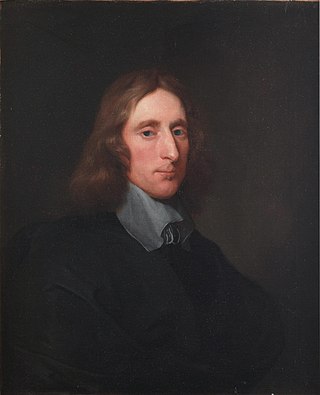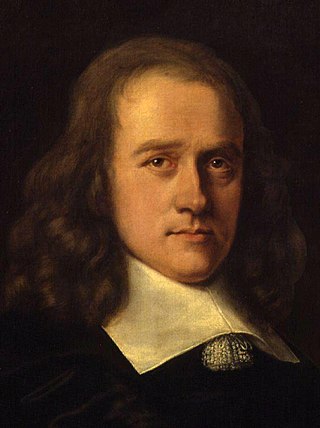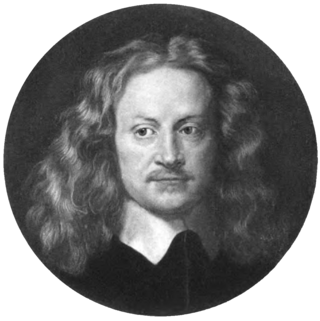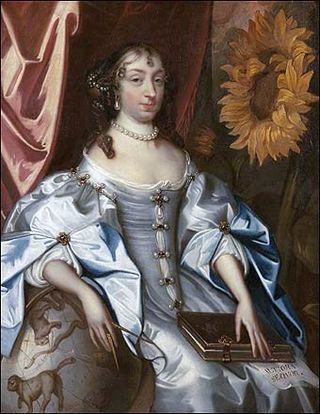Related Research Articles

Richard Cromwell was an English statesman who was the second and last Lord Protector of the Commonwealth of England, Scotland and Ireland and son of the first Lord Protector, Oliver Cromwell.

Colonel Edward Sexby was an English Puritan soldier and Leveller in the army of Oliver Cromwell. Later he turned against Cromwell and plotted his assassination.

John Thurloe was an English politician who served as secretary to the council of state in Protectorate England and spymaster for Oliver Cromwell and held the position of Postmaster General between 1655 and 1660. He was from Great Milton in Oxfordshire and of Lincoln's Inn,

John Jones Maesygarnedd was a Welsh military leader and politician, known as one of the regicides of King Charles I following the English Civil War. A brother-in-law of Oliver Cromwell, Jones was a Parliamentarian and an avid republican at a time when most of Wales was Royalist, and became one of 57 commissioners that signed the death warrant authorising the execution of Charles I following his trial. After the Restoration of the monarchy, Jones was one of few excluded from the general amnesty in the Indemnity and Oblivion Act, and was tried, found guilty, then hanged, drawn and quartered at Charing Cross.

The Third Protectorate Parliament sat for one session, from 27 January 1659 until 22 April 1659, with Chaloner Chute and Thomas Bampfylde as the Speakers of the House of Commons. It was a bicameral Parliament, with an Upper House having a power of veto over the Commons.

Henry Cromwell was the fourth son of Oliver Cromwell and Elizabeth Bourchier, and an important figure in the Parliamentarian regime in Ireland.
Anthony Hungerford (1614/15?–1657) was a Colonel in the English Parliamentary army who fought in Ireland during the War of the Three Kingdoms.
Edmund Dunch, 1st Baron Burnell of East Wittenham (1602–1678) was an English Member of Parliament who supported the Parliamentary cause before and during the English Civil War. During the Interregnum he sat as a member of parliament. In 1659, after the Protectorate and before the Restoration, regaining his seat in the Rump he also sat in Committee of Safety. After the restoration of the monarchy he was not exempted under the Act of Pardon and Oblivion but the titles granted to him under the Protectorate were not recognised under the restored monarchy of Charles II.
John Reynolds (1625–1657) was a soldier in the English Civil War and during the Commonwealth. Reynolds may have been a member of the Middle Temple. He joined the parliamentary army, and in 1648 he commanded a regiment of horse. He took part in the Cromwellian conquest of Ireland. He was a member of the Westminster-based Protectorate Parliament for Galway and Mayo in 1654 and Waterford and Tipperary in 1656. He was knighted in 1655. In 1657 he commanded the English force which cooperated with the French in Flanders in the Anglo-Spanish War and was lost at sea when returning to England.
Matthew Thomlinson (1617–1681) was an English soldier who fought for Parliament in the English Civil War. He was a regicide of Charles I. Tomlinson was a colonel of horse (cavalry) in the New Model Army and was one of the officers presenting the remonstrance to parliament in 1647. He took charge of Charles I in 1648, until Charles's execution, but refused to be his judge. He followed Oliver Cromwell to Scotland in 1650.
Robert Tichborne was an English soldier who fought in the English Civil War. He was a regicide of Charles I.
John Claypole was an officer in the Parliamentary army in 1645 during the English Civil War. He was created Lord Claypole by Oliver Cromwell, but this title naturally came to an end with the Restoration of 1660.

Elizabeth Claypole was the second daughter of Oliver Cromwell, Lord Protector of the Commonwealth of England, Scotland and Ireland, and his wife, Elizabeth Cromwell, and reportedly interceded with her father for royalist prisoners. After Cromwell created a peerage for her husband, John Claypole, she was known as Lady Claypole. She was buried in Westminster Abbey.
Sir Francis Russell, 2nd Baronet was a Member of Parliament and a soldier for the parliamentary cause during the English Civil War. During the Interregnum he held several positions including membership in Cromwell's House of Lords.
John Clarke, also known as John Clark, John Clerk, and John Clerke, was an English politician and Justice of the Peace who sat in the House of Commons from 1653 through 1660, and was a colonel in the Parliamentary army between 1651 and 1659.
The Other House, established by the Lord Protector Oliver Cromwell under the terms of the Humble Petition and Advice, was one of the two chambers of the parliaments that legislated for England and Wales, Scotland, and Ireland, in 1658 and 1659, the final years of the Protectorate.
Vincent Gookin (1616?–1659) was an English surveyor-general of Ireland. He represented Irish constituencies in the Protectorate parliaments. In 1655 he published two pamphlets deprecating the enforcement of orders for transplantation of Irish to Connaught. He was a man of strong religious convictions, and an ardent republican.

Sir Theophilus Jones, was an Irish soldier and government official of Welsh descent. One of five sons born to Lewis Jones, Bishop of Killaloe in the Church of Ireland, he formed part of a close-knit and powerful Protestant family.
During the Protectorate period (1653–1659) of the Commonwealth of England, the Lord Protector reserved the power previously held by the monarch to confer knighthoods, baronetcies and peerages.
Humphrey Mackworth was an English politician and soldier of Shropshire landed gentry origins. He was military governor of Shrewsbury, in succession to his father and namesake, for almost five years under the Protectorate, from 1655 until late in 1659. He represented Shrewsbury in the First, Second and Third Protectorate Parliaments.
References
- Clarke, Aidan (1999). Prelude to restoration in Ireland: the end of the Commonwealth, 1659-1660, Cambridge University Press, 1999. ISBN 0-521-65061-5, ISBN 978-0-521-65061-8. p.324 Index "Cooper Col. Thomas 33, 58, 60, 62, 69, 94n, 97, 98, 99, 100,1 03, 114-115, 119, 143, 151, 172, 264n"
- Conway Anne, et al.(1992). The Conway letters: the correspondence of Anne, Viscountess Conway, Henry More, and their friends, 1642-1684, Oxford University Press, 1992. p. 160 footnote.
- Noble, Mark (1784). Memoirs of the protectorate-house of Cromwell: deduced from an early period, and continued down to the present time, Volume II, Printed Pearson and Rollason, sold by R. Baldwin [etc.] London.
- Reid, James Seaton (1838). History of the Presbyterian Church in Ireland: comprising the civil history of the province of Ulster, from the accession of James the First, with a preliminary sketch of the progress of the reformed religion in Ireland during the sixteenth century and an appendix consisting of original papers, Volume 2, Whittaker. p. 299 footnote (12)
- Attribution
 This article incorporates text from this source, which is in the public domain : "Memoirs of the protectorate-house of Cromwell: deduced from an early period, and continued down to the present time" by Mark Noble (1784)
This article incorporates text from this source, which is in the public domain : "Memoirs of the protectorate-house of Cromwell: deduced from an early period, and continued down to the present time" by Mark Noble (1784)